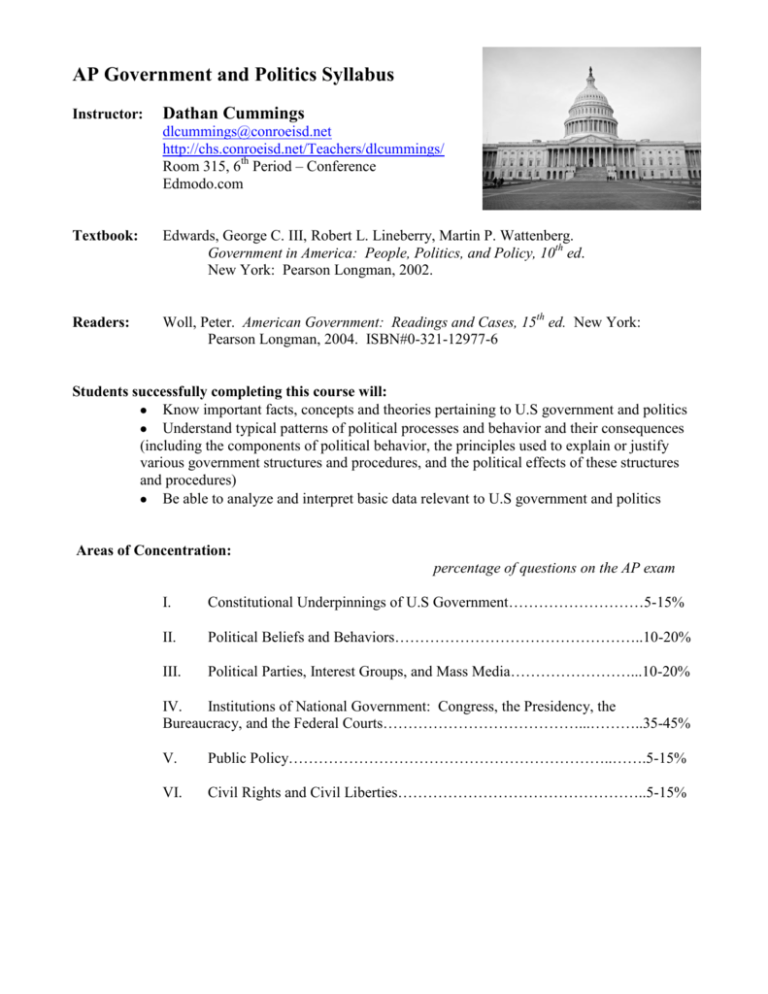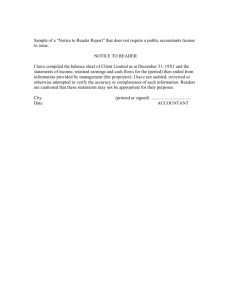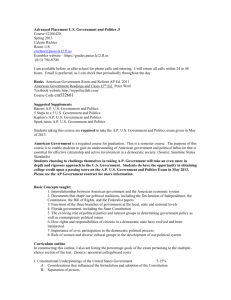
AP Government and Politics Syllabus
Instructor:
Dathan Cummings
dlcummings@conroeisd.net
http://chs.conroeisd.net/Teachers/dlcummings/
Room 315, 6th Period – Conference
Edmodo.com
Textbook:
Edwards, George C. III, Robert L. Lineberry, Martin P. Wattenberg.
Government in America: People, Politics, and Policy, 10th ed.
New York: Pearson Longman, 2002.
Readers:
Woll, Peter. American Government: Readings and Cases, 15th ed. New York:
Pearson Longman, 2004. ISBN#0-321-12977-6
Students successfully completing this course will:
Know important facts, concepts and theories pertaining to U.S government and politics
Understand typical patterns of political processes and behavior and their consequences
(including the components of political behavior, the principles used to explain or justify
various government structures and procedures, and the political effects of these structures
and procedures)
Be able to analyze and interpret basic data relevant to U.S government and politics
Areas of Concentration:
percentage of questions on the AP exam
I.
Constitutional Underpinnings of U.S Government………………………5-15%
II.
Political Beliefs and Behaviors…………………………………………..10-20%
III.
Political Parties, Interest Groups, and Mass Media……………………...10-20%
IV.
Institutions of National Government: Congress, the Presidency, the
Bureaucracy, and the Federal Courts…………………………………...………..35-45%
V.
Public Policy………………………………………………………..…….5-15%
VI.
Civil Rights and Civil Liberties…………………………………………..5-15%
Assessments and Grading Policy:
There will be eight major exams (not including the final). Each major exam will span two
days with two free response questions on the first day and a timed multiple choice portion on
the second day. Students will need to interpret data to answer both sections.
At least once every week there will be an in class free response question to assess student
understanding of course content. If data is presented in the form of a chart, graph, or table
during the week, that data will likely be the basis for the writing assignment.
Reading Quizzes are given BEFORE the chapter is discussed in class. Students are invited
and encouraged to ask questions in class or seek extra help with regard to material they may not
understand however, I will not answer any questions regarding the assigned reading the day of
the quiz. Students need to have the material read earlier than the night before the quiz.
Quizzes and Assignments
30% of Semester Grade
Major Exams (8)
70% of Semester Grade
Grade Average
100 – 90
89 – 80
79 – 75
74 – 70
69 – Below
Letter Grade
A
B
C
D
F
Materials:
Multi-subject spiral notebook or binder (you need a place to take notes and keep handouts)
Highlighters, pens, pencils
AP Exam:
Every student enrolled in AP Government and Politics is expected to take the AP exam in
May. Certain scores on this test will result in college credit hours at most universities.
Rules:
1. “Clear the Mechanism” – Come and remain focused during class.
2. Be prepared and on time for class.
3. Respect each other, the instructor, and any other authority figures present in the classroom.
4. Take pride in your work
Edmodo:
You are encouraged to join my AP Government and Politics Group on
Edmodo.com
After you log in or sign up enter this code
to be added to the group.
Units of Study
Intro.
Overview of United States Government and Politics
Textbook:
Chapter 1
1/2 Week
“Introducing Government in America”
Supplemental Readings:
“Democratic Practice and Democratic Theory,” Berelson, Lazarsfeld, and
McPhee, (Woll reader, p. 207) *
Key Topics:
Laswell’s Definition/Model of Politics
The U.S. Policymaking System
o Linkage Institutions
o Policy Agenda
o Policymaking Institutions
o Types of Public Policies
o Policy Effects
Theories of American Democracy
o Traditional Democratic Theory
o Pluralist Theory
o Elite/Class Theory
o Hyperpluralism
Challenges to Democracy in the United States
Current Trends in the U.S. Political System
Test 1
Unit 1
Constitution of the United States - Multiple Choice
Constitutional Underpinnings of United States Government
Textbook:
Chapter 2
2 Weeks
“The Constitution”
Supplemental Readings:
Excerpt from Second Treatise of Civil Government (handout)
The Federalist #10 (handout/textbook Appendix) **
The Federalist # 51 (handout/ Woll Reader, p. 44) **
Article 5 of the U.S. Constitution (textbook Appendix)
Key Topics:
The Influence of John Locke and Others on American Political Development
Liberty vs. Authority: A trend in American Political Development
The Articles of Confederation (structure and weaknesses)
Shays’ Rebellion as a Catalyst for Change
Motives of the Founding Father / The Fear of Factions
The Madisonian Model /Separation of Powers and Checks and Balances
Key Compromises at the Constitutional Convention
The Ratification Debate
Principles of the U.S. Constitution
Formal and Informal Amendment Processes
Test 2
Multiple Choice and Free Response
Textbook:
Chapter 3
“Federalism”
Supplemental Readings:
The Federalist #44 (Woll Reader, p. 57)
Article 1, Section 8 of the U.S. Constitution (text Appendix)
Article 6 – The Supremacy Clause of the U.S. Constitution (text Appendix)
Amendment 10 of the U.S. Constitution (text Appendix)
Article 4 of the U.S. Constitution (text Appendix)
McCulloch v. Maryland (Woll Reader, p. 69)
U.S. v. Morrison (Woll Reader, p. 88)
U.S. v. Lopez (handout)
From the The Price of Federalism (Paul Peterson, The Enduring Debate, p. 43)
Key Topics:
Division of Power in our Federal System (Types of Powers / Powers Denied)
Horizontal Federalism and Article 4 of the U.S. Constitution / Marital Rights
McCulloch v. Maryland
Evolution of our Federal System: Dual Federalism to Cooperative Federalism
The Role of Supreme Court Decisions in the Changing Nature of Federalism in
the 20th Century
Fiscal Federalism and the System of Federal Grants / Federal Sanctions
Funded vs. Unfunded Mandates
Devolution
Test 3
Unit 2
Multiple Choice and Free Response
Political Beliefs and Behaviors
Textbook:
Chapter 6
Chapter 9
Chapter 10
______ 2 Weeks
“Public Opinion and Political Action”
“Nomination and Campaigns”
“Elections and Voting Behavior”
Supplemental Readings:
Kevin Pobst, “Public Opinion Polls: Their Impact . . .” (Handout: Social
Education)
Buckley v. Valeo (Woll Reader, p. 219)
Myths and Realities about the Bipartisan Campaign Reform Act of 2002 (Woll
Reader, p. 232)
Bush v. Gore (Woll reader, pp. 424-428)
Amendment 12 (textbook Appendix)
Key Topics:
American Political Culture
Measurement of Public Opinion
The Political Socialization Process and Its Agents
Types of Political Participation and Their Effects
Analysis of Trends in Political Participation in the U.S.
The Political Spectrum: Liberalism and Conservatism and the American
“Middle”
Freedom vs. Order and Freedom vs. Equality (Analyzing Political Beliefs)
Ideological Conservatism vs. Liberalism in Practice (Mixed Signals from the
American Public?)
Demographic Differences in Political Beliefs and Behaviors (Analysis of Voting
Trends and Trends in Political Party Identification)
Nominations and Campaigns: Change Over Time
o Role of the party vs. Role of the People
o Candidate-Centered Campaigns – Is the Party Over?
o Types of Primaries, Who Participates, and Consequences for the Political
System
o Primaries vs. Caucuses and the Implications of Frontloading the
Schedule
o The Changing Nature of National Conventions
o Media Coverage of Campaigns
o Campaign Finance Reforms and Their Effectiveness
o The Role of PACs
o The 2008 Presidential Campaign
Types of Elections
The Campaign for the General Election
Voter Turnout Trends: General Election vs. Primaries; Presidential vs. OffPresidential Years
The Electoral College (How it works --- issues and flaws)
Election Laws
Test 4
Multiple Choice and Free Response
Unit 3
Linkage Institutions _____________
Textbook:
Chapter 8
Chapter 11
Chapter 7
2-3 Weeks
“Political Parties”
“Interest Groups”
“The Mass Media and the Political Agenda”
Supplemental Reading:
“Electoral Trends” (Data – Excerpt from The Modern Presidency, pp. 32-35)
“Interest Groups and the American Political System” (Woll Reader, pp. 256259)
“Politics by Other Means” by Benjamin Ginsberg and Martin Shefter (Woll
Reader, pp.200-206)
Key Topics:
Political Parties: Definition and Functions
Reasons for the Two Party System in the United States
Theory of Critical Elections
Evolution of the Two Party System: Realignment vs. De-alignment
Divided Government and Its Implications
The Decentralized Structure of American Political Parties
Democrats and Republicans: Their Similarities and Differences (Ideological
and Demographic)
Third Parties: Types and Significance
Interest Groups: Definition and Functions
Differences/Similarities between Interest Groups and Political Parties
Interest Group Strategies to Influence Policymaking (Lobbying, Litigation,
Electioneering [role of PACs], Going Public)
Types of Interest Groups / What Interests are Organized and Why (and who is
not)
Interest Group Effectiveness: Trends in Influence
The Mass Media: Types of Media and their Changing Significance
The Role of the Media in American Politics
o Voter perceptions
o Focus of the media in campaigns and elections
o The role of the media in agenda development and policymaking
o The role of the media in shaping the image of policymakers
o Symbiotic vs. conflicting relationship among candidates, policymakers
and the media
Test 5
Multiple Choice and Free Response
Unit 4
Institutions of National Government
Congress
Textbook:
Chapter 12
“Congress”
_____ 4-5 Weeks
Supplemental Readings:
“If, as Ralph Nader Says, Congress Is ‘The Broken Branch,’ How Come We
Love Our Congressmen So Much?” by Richard F. Fenno, Jr. (Woll reader, pp.
383-389)
“Congress: The Electoral Connection” by David R. Mayhew (Woll Reader, pp.
397-400)
Article 1 of the Constitution (textbook Appendix)
Amendment 17 (textbook Appendix)
Key Topics:
Member Characteristics and Their Implications for Democracy
Redistricting and Its Implications for Representation
Congressional Elections and Incumbent Advantage
Bicameralism /Formal and Informal Organization and Leadership of Congress
Congressional Reforms in the 20th Century
House and Senate Differences
Functions and Powers of Congress
How a Bill Becomes a Law / Factors That Influence the Law-Making Process
Checks and Balances: Congress and the Other Policymaking Institutions
Divided Government: Implications for Policymaking
Test 6
Textbook:
Multiple Choice and Free Response
Executive
Chapter 13
“The Presidency”
Chapter 15
“The Federal Bureaucracy”
Chapter 14
“The Congress, the President and the Budget: The
Politics
of Taxing and Spending”
Supplemental Readings:
Federalist #70 (Woll reader, pp. 272-274)
Presidential Power by Richard E. Neustadt (Woll reader, pp. 280-283)
James P. Pfiffner, “Going Public and Public Approval,” (The Modern
Presidency, pp. 35-43)
Youngstown Sheet and Tube Co. v. Sawyer (Woll Reader, pp. 299-303)
“U.S. Court Rules Secret Wiretaps Unconstitutional,” Karush, Sarah, AP,
Houston Chronicle, August 18, 2006.
Article 2 of the Constitution (textbook appendix)
Amendments 20, 22, and 25 of the Constitution (textbook Appendix)
Key Topics:
The Constitution and the President
The Roles of the President
The President and Public Approval / Going Public
Party Leadership and Party Support in Congress
Presidential Powers (formal and informal) and Checks and Balances
Expansion of Presidential Power in the 20th Century/Views of
Presidential Power
The Imperial Presidency vs. The Imperial Congress (Relationships
between the Branches)
The Structure of the Executive Branch / Centralization of Power in the
White House / Presidential Management Styles
The Bureaucrats: Political Appointees vs. Career Civil Servants
Structure and functions of the Bureaucracy: Cabinet Departments,
Independent Executive Agencies, Government Corporations, and Independent
Regulatory Agencies
Factors That Influence Bureaucratic Implementation of Public Policy
Bureaucrats as Policymakers
The Bureaucracy and Special Interest Group Influence
Checks and Balances: The Bureaucracy and Its Relationships with
Congress and the President
Definitions and Trends: Public Debt and Federal Deficits
Developing the Federal Budget: Goals vs. Reality
The Role of the President and the Role of the Congress in the Budget
Process
Discretionary vs. Mandatory Spending / The Politics of Taxing and
Spending Policies
Test 7
Multiple Choice and Free Response
Textbook
Federal Courts
Chapter 16
“The Federal Courts”
Supplemental Readings:
The Federalist # 78 (Woll Reader, pp. 409-413)
Article 3 of the Constitution (textbook Appendix)
Judicial Self-Restraint by John P. Roche (Woll reader, pp. 418-424)
How the Supreme Court Arrives at Decisions by William J. Brennan, Jr. (Woll
reader, pp. 428-435)
Constitutional Liberty and the Right to Abortion by Justice Sandra Day
O’Connor (Woll reader, pp.438-442)
Liberty and Abortion: A Strict Constructionist’s View by Justice Antonin Scalia
(Woll reader, pp. 444-445)
Key Topics:
The Constitution and the Federal Judiciary
Marbury v. Madison
Judicial Independence
The Structure of the Federal Court System
The Federal Judges / The Politics of Judicial Selection
The Courts as Policymakers
o
o
o
o
o
o
Unit 5
Accepting Cases
Self Imposed Limits
Following Precedent or Charting New Ground
Judicial Self-Restraint vs. Judicial Activism
Implementing Court Decisions
The Supreme Court and Public Opinion
Public Policy
Textbook:
1 Week
Chapter 17
Chapter 18
Chapter 19
Chapter 20
Economic Policymaking
Social Welfare Policymaking
Policymaking for Health Care and the Environment
Foreign and Defense Policymaking
Key Topics:
Interactions among key players, interests, institutions and processes
Identification of stages in the policy process (formation, implementation, and
interpretation)
Effects of federalism, interest groups, parties and elections on policy processes
and policymaking
Identification of major public policies in each topic area.
Test 8
Unit 6
Multiple Choice and Free Response
Civil Rights and Civil Liberties
Textbook:
Chapter 4
Chapter 5
1 Week
“Civil Liberties and Public Policies”
“Civil Rights and Public Policies”
Supplemental Readings:
Engel v. Vitale (Woll reader, pp. 136-142)
Gideon v. Wainwright (Woll reader, pp. 108-113)
Roe v. Wade (Woll reader, pp. 146-154)
Plessy v. Ferguson (Woll reader, pp. 125-127)
Brown v. Board of Education of Topeka, 1954, 1955 (Woll reader, pp. 128-133)
Amendments 1-10, 13, 14, 15, 19, 23, 24, 26 of the U.S. Constitution (textbook
Appendix)
Key Topics:
The Bill of Rights and the States Then and Now / Selective Incorporation
Supreme Court Interpretation of Constitutional Rights via Analysis of Cases
First Amendment: Establishment Clause, Freedom of Religion, Speech, Press,
Assembly, and Petition
Rights of the Accused: The Fourth, Fifth, Sixth And Eighth Amendments and
The Right to Privacy and the Supreme Court’s Interpretation of the Constitution
The Significance of the 14th Amendment’s Due Process and Equal Protection
Clauses
Legislation, Court Decisions, and Mass Movements in the Development of the
Political and Civil Rights of Minorities, Women, and the Disabled
Final Exam





